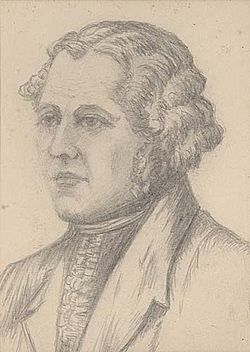William Booth (forger) facts for kids
Quick facts for kids
William Booth
|
|
|---|---|

Pencil sketch of Booth, artist unknown
|
|
| Born |
Hall End Farm near Beaudesert, Warwickshire, England
|
| Died | 15 August 1812 |
| Resting place | St Mary's Church, Handsworth |
| Nationality | English |
| Occupation | Farmer |
| Conviction(s) | Forgery |
| Criminal penalty | Death by hanging |
William Booth (1776–1812) was an English farmer and forger, who was hanged for his crimes. He is the subject of the song "Twice Tried, Twice Hung, Twice Buried" by Jon Raven and a book. Several geographical features in Birmingham, near his former home, carry his name.
Contents
Early life
Booth was born at Hall End Farm near Beaudesert, Warwickshire and was baptised at the church there on 21 February 1776. He was one of eight children of a farmer and church warden, John Booth, and his wife Mary.
On 28 February 1799, Booth signed a 25-year lease for what became known (by 1821 if not earlier) as "Booth's Farm", including a farmhouse and 200 acres of land, part of the Perry Hall estate. The farm was then in Perry Barr, Staffordshire; that part of Perry Barr is now known as Great Barr, and is in the city of Birmingham.
Booth, then descried as a yeoman, was accused of murdering his brother John while revisiting Hall End on 19 February 1808, but was acquitted for lack of evidence.
Co-conspirators
Booth's accomplices were tried alongside him and those convicted were sentenced to transportation to Australia.
Elizabeth Chidlow (or Chedlow) was sentenced to 14 years, departing in August 1813 on the Wanstead.
and received £5 from them as it was their charitable custom to support women sentenced to transportation for forgery. She arrived at Port Jackson (now Sydney), New South Wales on 9 January 1814.
George Scot and John Yates Snr., were each sentenced to be transported for seven years. All the other defendants were acquitted. Booth's wife, who witnesses said was active in the process of making forgeries, was not charged, as wives were considered to be under the control of their husbands.
Booth's Farm
The farmhouse was demolished in 1974, much of the farm – still known as Booth's Farm – having been sold off for housing. An archaeological excavation was conducted at that time. As late as October 1956, 45 bank tokens forged by Booth, using metal alloy instead of silver, were found in a garden on Foden Road, formerly part of the farm.
What remained of the farm became a sand and gravel quarry (the site is on Bunter Pebble Beds), and later a landfill site and eventually a nature reserve, with additional housing built in the 2010s. During the latter period, the buried foundations of the farmhouse were re-exposed and an information board placed alongside them.
Namesakes
Booth and his farm gave their name to the still-extant Booths Lane and Booths Farm Road, now separated from each other by the M6 motorway which bisected the former farm when it opened circa 1972. In the 21st century, Forgers Walk —the pedestrian tunnel under the motorway—and later Booths Farm Walk, Booths Farm Close, Forger Lane, and Token Rise, all nearby, were so named.
Until the late 1920s, the farm was occupied by the Foden Family, commemorated in Foden Road.
The area around Booths Farm Road is known as the Booths Farm Estate.




